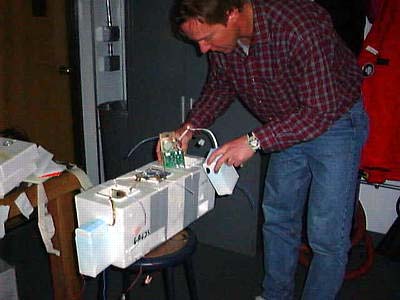13 January, 1999
Wednesday, January 13th, 1999, South Pole Station
A wonderful day to every body from the very South of the world!
Today, we had a 7:30 a.m. meeting for our tour through the 'Dark
Sector' of the South Pole Station. Remember, I told you that the
Station is divided into several sectors. The 'Dark Sector' is the part
of the station where astrophysical research is conducted. It is one of
the restricted sectors and is therefore located further away from the
dome. This restriction minimizes light, pollution, and electronic
interference. The building contain several projects.
One of the projects is called AMANDA( Antarctic Muon and Neutrino
Detector Array). Sue Bowman, the other teacher here at the South,
parcticipates in the research., It uses the deep ice at the South Pole
as the largest Neutrino Telescope on Earth. The detector looks
downward into the ice to detect the path of neutrinos that pass
through the Earth, which helps us to understand the structure of the
early universe. The project CARA (Center for Astrophysical Research in
Antarctica) takes advantages of superior seeing conditions which are
made possible by the low temperature and near absence of water vapor
in the atmosphere. Large telescopes can gather data with the potential
to answer questions about the formation of the universe, such as how
stars are formed. The project SPIREX (South Pole Infrared Explorer)
uses infrared light to detect star formation in far distances. I was
impressed by all the telescopes and technology and was glad to have
had a chance to observe it all.
In between answering emails, we met with the halo specialists from
Finland, Marko Riikonen and Jarmo Moilanen. Sue, Bryan, and I enjoyed
their recording of special light reflections, which are formed
because of different ice crystals in the air. It was interesting to
hear how the special 'glow' around the sun is formed.
After lunch, Bryan and I worked all afternoon on preparing for our
triple-ozone sonde flight. Before I talk about our next launch lets
look at yesterday's question: What do you think a 'weigh-off-weight'
is? Why do you think we have to be careful inflating the balloon with
the right amount of helium? The 'weigh-off-weight' is the weight the
balloon has to lift so that the experimental instruments will not
'drag' along the ground. That would not be a good idea. So, we weigh
the instruments and add 20% of its weight just to make sure that the
balloon can lift the package with the ozonesonde. We used enough
helium for the double sonde to lift 2000gr and for the triple sonde
about 3500gr.
OZONE EXPERIMENT WITH TRIPLE OZONES:
Two triple ozonesonde will be tested ( two replicates: total 6
ozonesondes)
1. the first set will contain the 1% KI buffered solution
2. the second set will contain the 2% KI, unbuffered solution
Each triple-ozone set will have the following model of ozonesondes: a)
Old Model (4A) used since the 80'ties Features: - 6v motor pump
- Teflon electrochemical cells connected to gears (no
electronical interface )
- Analog data is collected
b) New model ( 6A) , used since the 90'ties
Features: - 12v motor pump
- Teflon electrochemical cells
- electronical interface, digital data collects
c) New model (2Z) similar to above except different material (molded
plastic instead of Teflon) for
electrochemical cells.
We prepared two sets of these sondes and are ready for the launch
tomorrow!!
I have still trouble falling asleep with all the sunshine around me.
So, when all went to bed, I stayed up writing journals and answering
emails. When I left the ARO building at 3a.m., I took advantage of the
different angle of the sun and took some pictures and walked around a
bit. It is now 5 a.m. and it looks like we are getting our first
storm. Time to go to bed. Left a note for Bryan to wake me up for the
ozone launch. Since it is late/early, I will answer the questions
posted yesterday later today. Cheers, until later. The question for
today is: at what angle do you think the sun is up and would the angle
change in 24 hours?

Visiting the 'Dark sector' , which is about 1/2 a mile from the station. This section includes labs for astrophysical research.

Bryan is placing an ozonesonde into the triple-ozonesonde container. All three sondes will be launched together, comparing different ozonesonde models.

Triple-ozonesondes from the top view and -- hello from me --I jumped into the picture.

A close-up of an ozonesonde. Bryan is pointing at the electrochemical cells, where the ozone concentration is measured.
Contact the TEA in the field at
.
If you cannot connect through your browser, copy the
TEA's e-mail address in the "To:" line of
your favorite e-mail package.
|
